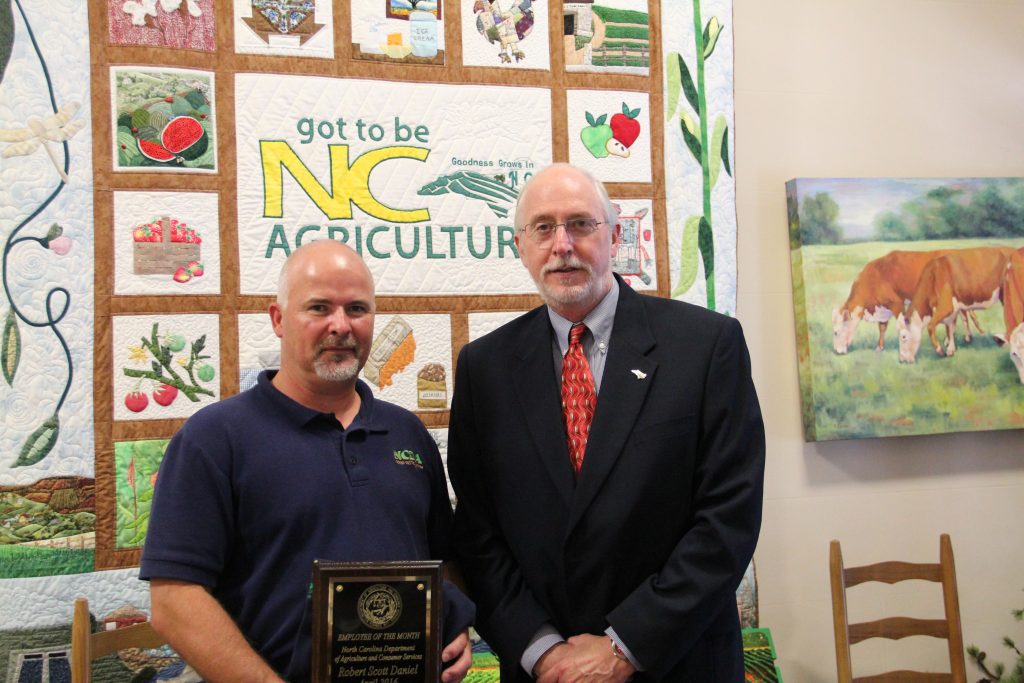Press release from the N.C. Department of Agriculture and Consumer Services:
The Food Distribution Division was busier than ever in 2020. An extra way the division provides food to schools has also been busier than ever during the coronavirus pandemic. It’s called Bob’s List, and it’s enabled many school nutrition programs to keep their operations on budget and get food to the children who need it.
“We still aren’t in a normal operating mode, and all of our programs need as much help as possible to stabilize themselves and continue to operate,” said Carolyn Barton, the director of school nutrition services in Transylvania County Schools.
Bob’s List was named after Bob Sitton, who retired in December of 2020. He worked in the Food Distribution Division for 20 years, serving as assistant director for 12 years. Bob’s List is sort of an electronic billboard that shows school nutrition programs any USDA food “that doesn’t have a home,” explained division director Gary Gay. The extra food comes from other school systems that won’t be able to use the food for various reasons such as unexpected snow days or the requirement to order full shipments even if the system can’t use quite all of the shipment. Fewer in-person school days has also been a major reason extra food has been put on Bob’s List since March of 2020.
Barton explained that although there have been efforts – both last spring and this past fall – to still get food to children at their homes, it’s been impossible to reach every child who would have normally gotten a meal at school. Also, Gay said the fall food orders were made last spring just before the pandemic began shutting down in-person instruction. So it was too late to adjust the fall orders.
Barton has been in school nutrition in Transylvania County for 23 years, and she said it was usually a surprise in previous years when extra food was available on Bob’s List. In 2020, she’s been able to get lots of USDA commodities from Bob’s List.
“So anytime I can go out there and get something for free, of course I’m going to do it,” she said.
Barton explained that’s especially important because school nutrition programs are enterprise funds, meaning they fund themselves without money from school district budgets. The instability caused by COVID-19 has made it difficult for school nutrition programs like hers to make ends meet. For example, Barton said when the school year began this past fall, her program saw only 37 percent of the normal sales volume, but her costs for food and labor didn’t go down. So the free food from Bob’s List was a huge help, and one benefit of all districts having lower volumes was that she and others could take advantage of all the extra food.
While other programs have helped as well, Barton said Bob’s List has been a big piece of the puzzle.
“It’s taken a lot of pressure off,” Barton said. “Bob’s List is one of those things that this year has saved us from going over the edge of the cliff and helped us to feed children who really need help.”
Gay said he’s been really happy to see Bob’s List work so well.
“It’s great because we get calls every week – almost every day – because [school nutrition programs] need to refuse USDA food because their school refrigerators or freezers are full and they can’t take it,” Gay said. “It’s really worked out for everyone – the people with surpluses and the ones who need it.”
The success of Bob’s List and other programs has made Barton think of continuing efforts into the future. She’s always thinking about the children who still need food but that are still out of reach in times like this – for example, those children who live too far away from a food delivery route or those who weren’t at school to take home a multi-day food package for those alternating days of online learning at home.
“I’ve seen the hungry faces. I’ve seen the kids eating out of other children’s plates,” Barton said. “I think we all care about our own children, at least I hope we do. What people don’t understand is that there are some working parts of this puzzle that can be returned and reworked to continue doing what we’re doing to climb out of this hole that we’re in.”
She hopes for state and federal funding to help continue programs that aid in school nutrition efforts. She sees ways to tweak the programs that have worked well during the pandemic, and she believe they could use local commodities to benefit North Carolina’s farmers, local businesses and local economies. At a minimum, Barton would like to see state leaders at least come together to talk about possible solutions and, in her words, “think it forward.”
“The extra product I’ve been able to get this year has been able to stabilize my program and help where it’s needed to feed the children who really it,” Barton said. “It’s working really well right now, so let’s focus on that good and keep the ball rolling.”




Before you comment
The comments section is here to provide a platform for civil dialogue on the issues we face together as a local community. Xpress is committed to offering this platform for all voices, but when the tone of the discussion gets nasty or strays off topic, we believe many people choose not to participate. Xpress editors are determined to moderate comments to ensure a constructive interchange is maintained. All comments judged not to be in keeping with the spirit of civil discourse will be removed and repeat violators will be banned. See here for our terms of service. Thank you for being part of this effort to promote respectful discussion.